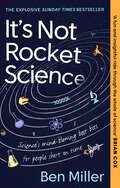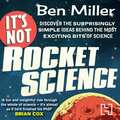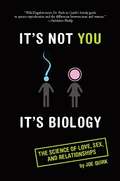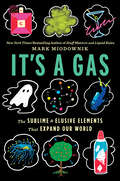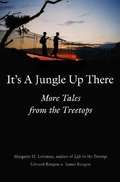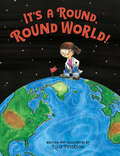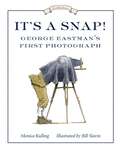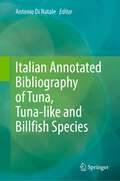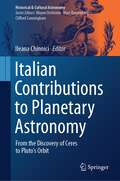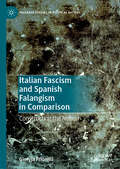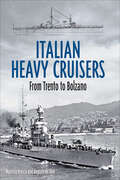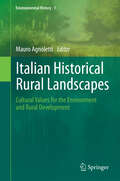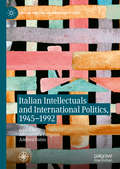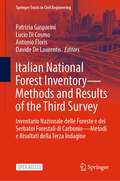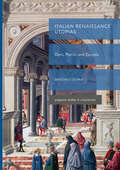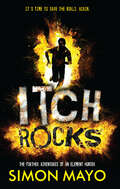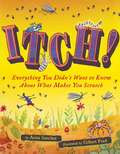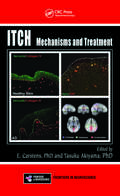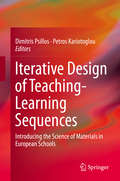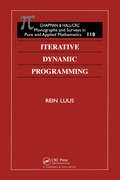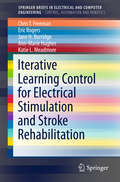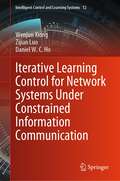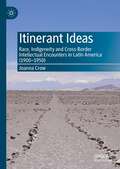- Table View
- List View
It's Not Rocket Science
by Ben MillerThe Top Ten Bestseller Black holes. DNA. The Large Hadron Collider. Ever had that sneaking feeling that you are missing out on some truly spectacular science? You do? Well, fear not, for help is at hand. Ben Miller was working on his Physics PhD at Cambridge when he accidentally became a comedian. But first love runs deep, and he has returned to his roots to share with you all his favourite bits of science. This is the stuff you really need to know, not only because it matters but because it will quite simply amaze and delight you. 'Let me show you another, perhaps less familiar side of Science; her beauty, her seductiveness and her passion. And let's do it quickly, while Maths isn't looking' Ben Miller 'This book makes climate change actually seem interesting. Not just important - it's obviously important - but interesting. As a result I bought lots of other books about climate change, something I now regret' David Mitchell Ben Miller is, like you, a mutant ape living through an Ice Age on a ball of molten iron, orbiting a supermassive black hole. He is also an actor, comedian and approximately one half of Armstrong & Miller. He's presented a BBC Horizon documentary on temperature and a Radio 4 series about the history of particle physics, and has written a science column for The Times. He is slowly coming to terms with the idea that he may never be an astronaut.
It's Not Rocket Science
by Ben MillerThe Top Ten BestsellerBlack holes. DNA. The Large Hadron Collider. Ever had that sneaking feeling that you are missing out on some truly spectacular science? You do? Well, fear not, for help is at hand. Ben Miller was working on his Physics PhD at Cambridge when he accidentally became a comedian. But first love runs deep, and he has returned to his roots to share with you all his favourite bits of science. This is the stuff you really need to know, not only because it matters but because it will quite simply amaze and delight you. 'Let me show you another, perhaps less familiar side of Science; her beauty, her seductiveness and her passion. And let's do it quickly, while Maths isn't looking' - Ben Miller 'This book makes climate change actually seem interesting. Not just important - it's obviously important - but interesting. As a result I bought lots of other books about climate change, something I now regret'- David MitchellBen Miller is, like you, a mutant ape living through an Ice Age on a ball of molten iron, orbiting a supermassive black hole. He is also an actor, comedian and approximately one half of Armstrong & Miller. He's presented a BBC Horizon documentary on temperature and a Radio 4 series about the history of particle physics, and has written a science column for The Times. He is slowly coming to terms with the idea that he may never be an astronaut.
It's Not Rocket Science
by Ben MillerThe Top Ten BestsellerBlack holes. DNA. The Large Hadron Collider. Ever had that sneaking feeling that you are missing out on some truly spectacular science? You do? Well, fear not, for help is at hand.Ben Miller was working on his Physics PhD at Cambridge when he accidentally became a comedian. But first love runs deep, and he has returned to his roots to share with you all his favourite bits of science. This is the stuff you really need to know, not only because it matters but because it will quite simply amaze and delight you.'Let me show you another, perhaps less familiar side of Science; her beauty, her seductiveness and her passion. And let's do it quickly, while Maths isn't looking' - Ben Miller'This book makes climate change actually seem interesting. Not just important - it's obviously important - but interesting. As a result I bought lots of other books about climate change, something I now regret'- David MitchellBen Miller is, like you, a mutant ape living through an Ice Age on a ball of molten iron, orbiting a supermassive black hole. He is also an actor, comedian and approximately one half of Armstrong & Miller. He's presented a BBC Horizon documentary on temperature and a Radio 4 series about the history of particle physics, and has written a science column for The Times.He is slowly coming to terms with the idea that he may never be an astronaut.
It's Not You, It's Biology.: The Science of Love, Sex, and Relationships
by Joe QuirkAt last, here's what you should've learned in high school biology! This paperback edition is an Everyman's humorous look at the real differences--biological, historical, psychological--between men and women...with fun and provocative insight into what really drives behavior and interactions between men and women. Men talk about women to men. Women talk about men to women. Men and women talk to each other (or try to) about relationships. It's Not You, It's Biology provides insight, ammunition, snappy comebacks, and interesting cocktail party banter for everyone who ever wondered why we do what we do vis-a-vis the opposite sex. It's Freakonomics for the Relationship-Challenged.
It's a Gas: The Sublime and Elusive Elements That Expand Our World
by Mark MiodownikThe New York Times bestselling author of Stuff Matters presents a rollicking guided tour of the secret lives of gases: the magnificent, strange, and fascinating substances that shape our world.Gases are all around us—they fill our lungs, power our movement, create stars, and warm our atmosphere. Often invisible and sometimes odorless, these ubiquitous substances are also the least understood materials in our world, and always have been. It wasn’t long ago that gases were seen as the work of ancient spirits: the sudden closing of a door after a change in airflow signaled a ghost’s presence. Scientists and engineers have struggled with their own gaseous demons. The development of high-pressure steam power in the eighteenth century literally blew away some researchers, ushering in a new era for both safety regulations and mass transit. And carbon dioxide, that noxious by-product of fossil fuel consumption and cow burps, gave rise to modern civilization. Its warming properties known for centuries, it now spells ruin for our fragile atmosphere. In It’s a Gas, bestselling materials scientist Mark Miodownik chronicles twelve gases and technologies that shaped human history. From hydrogen, carbon dioxide, and neon to laughing gas, steam, and even wind, the story of gases is the story of the space where science and belief collide, and of the elusive limits of human understanding.
It's a Jungle Up There: More Tales from the Treetops
by Margaret D. Lowman Edward Burgess James Burgess Ghillean T. PranceDrawn to the mysteries of tropical rain forests and fascinated by life in the treetops, Meg Lowman has pursued a life of scientific exploration while raising her two sons, Edward and James Burgess. This book recounts their family adventures in remote parts of the world (Samoa, West Africa, Peru, Panama, India, Biosphere 2, and others), from the perspectives of both kids and parent. Together they explore tropical rain forests, encounter anacondas and piranhas, eat crickets as hors d'oeuvres, discover new species, and nurture a family ethic for conservation. The chapters of the book focus on field biology questions, the canopy access methods developed to answer the questions, and conservation or education components of each expedition. Lowman enumerates the challenges and joys of juggling parenthood and career, and the children reflect on how their mom's work has affected their lives. A rollicking, inspiring book,It's a Jungle Up There is an upbeat portrayal of how a parent's career can imprint children, and how children in turn can influence the success and trajectory of their parent's career.
It's a Round, Round World! (A Joulia Copernicus Book)
by Ellie PetersonWe all know the earth is round. But HOW do we know? Join intrepid young scientist-adventurer Joulia Copernicus as she takes readers on a historical journey through time and space. From jumping on board Columbus's ship to planet-hopping in the outer reaches of our solar system, Joulia explains with humor and wit the ins and outs of how we learned that the earth is round.
It's a Snap!: George Eastman's First Photo (Great Idea Series #1)
by Monica KullingIn 1877 in Rochester, New York, George Eastman couldn’t understand why picture-taking was so difficult. Having left school at fourteen to support his mother and two sisters, George decided to find out by making photography his hobby. He packed up glass plates, a plate holder, a tent, a heavy tripod, a thick piece of black cloth, a water jug, and chemicals and set off to take his first photograph. George realized that not many people could own a camera — they were too expensive and the size of today’s microwave ovens! But how could he make picture-taking easier? Eventually, George created dry plates, and they were such a success that he opened his own dry-plate company in 1881. But this was only the beginning — George went on to invent film and the Brownie camera. The rest is history.Monica Kulling’s spunky, playful text is beautifully complemented by the stunning pen-and-ink with watercolor illustrations of artist Bill Slavin. It’s a Snap! George Eastman’s First Photo introduces a new series for Tundra — the Great Idea Series — a must-have for schools, libraries, and parents alike.
Italian Annotated Bibliography of Tuna, Tuna-like and Billfish Species
by Antonio Di NataleThe Italian-annotated bibliography on tunas, tuna-like and billfish species is a sort of unicum, because for the very first time, it provides annotation in English for all papers published by Italian authors over the centuries in various languages. Taking into account that these species are an essential component of the Italian and Mediterranean culture, thousands of authors published a very high amount of papers since historical times, on various themes and subjects. These large fish species are nowadays not only essential elements of the marine trophic chain, but also important components of human seafood and the related fishery economy. This book makes all these papers internationally available for all scientists, helping them in their research activities and the annotations facilitate the searching work by species and keywords.
Italian Contributions to Planetary Astronomy: From the Discovery of Ceres to Pluto's Orbit (Historical & Cultural Astronomy)
by Ileana ChinniciThis book describes the most important contributions of Italian astronomers to the development of planetary astronomy during the nineteenth century and the early part of the twentieth century. This journey through what may be regarded as the golden era of Italian astronomy commences with the discovery of Ceres, the first asteroid, now classified as a dwarf planet, and culminates in the role played by the Padua Observatory in calculating Pluto’s orbit in the 1930s. Along the way, a wealth of information is provided on the discovery of many comets and asteroids, early spectroscopic observations, drawings of planets and comets, calculations of orbits and ephemerides, and much more. The contributions of such famous figures as Giovanni Schiaparelli, Giovanni Battista Donati, Angelo Secchi, and Annibale De Gasparis are fully explained. Many of the described results are still of interest for modern astronomy, and the book appeals to a wide readership, including scholars, historians, astronomers, and the general public.
Italian Fascism and Spanish Falangism in Comparison: Constructing the Nation (Palgrave Studies in Political History)
by Giorgia PriorelliThis book compares the Italian Fascist and the Spanish Falangist political cultures from the early 1930s to the early 1940s, using the idea of the nation as the focus of the comparison. It argues that the discourse on the nation represented a common denominator between these two manifestations of the fascist phenomenon in Mussolini’s Italy and Franco’s Spain. Exploring the similarities and differences between these two political cultures, this study investigates how Fascist and Falangist ideologues defined and developed their own idea of the nation over time to legitimise their power within their respective countries. It examines to what extent their concept of the nation influenced Italian and Spanish domestic and foreign policies. The book offers a four-level framework for understanding the evolution of the fascist idea of the nation: the ideology of the nation, the imperial projects of Fascism and Falangism, race and the nation, and the place of these cultures in the new Nazi continental order. In doing so, it shows how these ideas of the nation had significant repercussions on fascist political practice.
Italian Heavy Cruisers: From Trento to Bolzano
by Maurizio Brescia Augusto de ToroA technical history of seven Italian heavy cruisers: Trento, Trieste, Bolzano, Zara, Fiume, Gorizia, Pola—a perfect companion volume to Italian Battleships.When the Washington Naval Treaty of 1922 effectively banned the building of battleships, competition between the major navies concentrated on the next most powerful category, heavy cruisers limited to ten thousand tons displacement and eight-inch guns. Italy followed this trend, the first design for what became Trento and Trieste being ordered in 1924. These were the fastest of the first generation ‘Treaty’ cruisers but were very lightly armored, and the succeeding Zara class of four ships were slower but better protected. However, before the final ship of this class (Pola) had been completed, there was a return to the earlier fast, lightly protected concept with the Bolzano, although this ship also incorporated aspects of the Zara design. The political background, design history and technical features of these classes are covered in great depth in this volume. They were important ships, subject to incremental improvement so no two were identical, and model makers will appreciate the space devoted to the variations in appearance, using both description and illustration. As major units of the Italian battle fleet, they were more active than most during the war and their careers are fully detailed, including analyses of damage suffered. Tragically, they were all sunk, and the circumstance of each loss is explored. As befits a technical history, the book is thoroughly illustrated with ship and armament plans, detail drawings and color camouflage schemes, as well as an outstanding collection of photographs.
Italian Historical Rural Landscapes
by Mauro AgnolettiSustainable development and rural policies have pursued strategies where farming has been often regarded as a factor deteriorating the ecosystem. But the current economic, social and environmental problems of the Earth probably call for examples of a positive integration between human society and nature. This research work presents more than a hundred case studies where the historical relationships between man and nature have generated, not deterioration, but cultural, environmental, social and economic values. The results show that is not only the economic face of globalization that is negatively affecting the landscape, but also inappropriate environmental policies. The CBD-UNESCO program on biocultural diversity, the FAO Globally Important Agricultural Heritage Systems and several projects of the International Union of Forest Research Organizations, as well as European rural policies acknowledge the importance of cultural values associated to landscape. This research intends to support these efforts.
Italian Intellectuals and International Politics, 1945–1992 (Italian and Italian American Studies)
by Alessandra Tarquini Andrea GuisoItalian intellectuals played an important role in the shaping of international politics during the Cold War. The visions of the world that they promulgated, their influence on public opinion and their ability to shape collective speech, whether in agreement with or in opposition to those in power, have been underestimated and understudied. This volume marks one of the first serious attempts to assess how Italian intellectuals understood and influenced Italy’s place in the post–World War II world. The protagonists represent the three key post-war political cultures: Catholic, Marxist and Liberal Democratic. Together, these essays uncover the role of such intellectuals in institutional networks, their impact on the national and transnational circulation of ideas and the relationships they established with a variety of international associations and movements.
Italian National Forest Inventory—Methods and Results of the Third Survey: Inventario Nazionale delle Foreste e dei Serbatoi Forestali di Carbonio—Metodi e Risultati della Terza Indagine (Springer Tracts in Civil Engineering)
by Patrizia Gasparini Lucio Di Cosmo Antonio Floris Davide De LaurentisThis open access book deals with the methods and the results of the third Italian national forest inventory (INFC2015). Arma dei Carabinieri is entrusted with the realisation of the National Forest Inventory and with the decisions about the aims of the survey and data treatment. National forest inventories produce statistically based information on forests over country areas. Such information is used either at subnational or at supranational level in a great number of spheres and processes, included possibility to depict the status of the world forests. Italy conducted its first forest inventory in 1985 and in 2001 a permanent national forest inventory was launched to have periodically updated statistics. Due to the growing concern about the environment and especially the climate change, estimating forests carbon pools was a stated main objective and it was accordingly named Italian National Inventory of Forest and Forest Carbon Pools (INFC). The book begins with a description of the general organisation, the definitions, the methods and the estimation procedures. It proceeds showing the main estimates produced by INFC2015, in tables that are given in the book chapters. The estimates are presented through texts that introduce the subject matter, explain the way the related variables were surveyed and comment on the main outcomes with the help of graphics. The estimates presented include forest area, management and production, biodiversity and protection, forest health, protective and socio-economics functions. Role of forest in the carbon balance was analysed in a specific Chapter, as this is important for its role in the climate change mitigation. The book ends providing an understanding of the current dynamics of Italian forests by comparing the estimates obtained from INFC2005 and INFC2015, the last two national surveys.
Italian Renaissance Utopias: Doni, Patrizi, and Zuccolo (Palgrave Studies in Utopianism)
by Antonio DonatoThis book provides the first English study (comprehensive of introductory essays, translations, and notes) of five prominent Italian Renaissance utopias: Doni’s Wise and Crazy World, Patrizi’s The Happy City, and Zuccolo’s The Republic of Utopia, The Republic of Evandria, and The Happy City. The scholarship on Italian Renaissance utopias is still relatively underdeveloped; there is no English translation of these texts (apart from Campanella’s City of Sun), and our understanding of the distinctive features of this utopian tradition is rather limited. This book therefore fills an important gap in the existing critical literature, providing easier access to these utopian texts, and showing how the study of the utopias of Doni, Patrizi, and Zuccolo can shed crucial light on the scholarly debate about the essential traits of Renaissance utopias.
Itch Rocks: The Further Adventures of an Element Hunter
by Simon MayoItchingham Lofte is back—and now hes the most protected boy in the world! After narrowly escaping the thugs from Greencorps and disposing of element 126, Itch and his family live under constant surveillance by Englands famed MI5. But even these top agents may not be able to help him when enemies old and new scheme to get their hands on the super-radioactive rocks—even if they have to kill Itch to do it. Filled with danger, thrills, and some shocking surprises, this suspenseful sequel is every bit as exciting as the first!
Itch!: Everything You Didn't Want to Know About What Makes You Scratch
by Gilbert Ford Anita SanchezEverybody gets itchy, and every kid will love this title that scratches the itch to know more and about the history, anatomy, botany, biology behind it. Perfect for fans of Grossology books looking for something more substantive and dynamic. You can feel it coming on—that terrible, tortuous ITCH. As irritating as an itch is, it is also your body’s way of sending you a message you can’t miss, like you’ve brushed up against poison ivy or lice have taken up residence in your hair. None of which you’d know without that telltale itch! And there are so many things that make us itch—from fungus to fleas, mosquitoes to nettles, poison ivy to tarantulas! Combining history, anatomy, laugh-out-loud illustrations, and even tips to avoid—and soothe—the itch, Anita Sanchez and Gilbert Ford take readers on an intriguing (and sometimes disgusting) look into what makes you scratch.
Itch: Mechanisms and Treatment (Frontiers in Neuroscience)
by E. Carstens Tasuku AkiyamaAdvances in itch research have elucidated differences between itch and pain but have also blurred the distinction between them. There is a long debate about how somatic sensations including touch, pain, itch, and temperature sensitivity are encoded by the nervous system. Research suggests that each sensory modality is processed along a fixed, direc
Iterative Design of Teaching-Learning Sequences
by Dimitris Psillos Petros KariotoglouThis book addresses a very important aspect of science education and science education research respectively: The research-based development of Teaching Learning Sequences. The authors elaborate on important theoretical issues as well as aspects of the design and iterative evolution of a several Teaching Learning Sequences in a modern scientific and technological field which is socially relevant and educationally significant. The book is divided into two parts. The first part includes a collection of papers discussing the theoretical foundations and characteristics of selected theoretical frameworks related to designing Teaching Learning Sequences, elaborate on common issues and draw on the wider perspective of design research in education. The second part contains a collection of papers presenting case studies concerning the design, implementation, iterative evolution and evaluation of Teaching and Learning Sequences in a variety of educational context. The case studies deal with a more or less new subject matter, a part of modern interdisciplinary science, material science, which enhances the connections between science and technology. From a wider perspective the case studies draw on existing theoretical ideas on inquiry in various contexts and provide powerful suggestions for contextualized innovation in a variety of school systems and existing practices.
Iterative Dynamic Programming (Monographs and Surveys in Pure and Applied Mathematics)
by Rein LuusDynamic programming is a powerful method for solving optimization problems, but has a number of drawbacks that limit its use to solving problems of very low dimension. To overcome these limitations, author Rein Luus suggested using it in an iterative fashion. Although this method required vast computer resources, modifications to his original schem
Iterative Learning Control for Electrical Stimulation and Stroke Rehabilitation
by Chris T. Freeman Eric Rogers Jane H. Burridge Ann-Marie Hughes Katie L. MeadmoreIterative learning control (ILC) has its origins in the control of processes that perform a task repetitively with a view to improving accuracy from trial to trial by using information from previous executions of the task. This brief shows how a classic application of this technique - trajectory following in robots - can be extended to neurological rehabilitation after stroke. Regaining upper limb movement is an important step in a return to independence after stroke, but the prognosis for such recovery has remained poor. Rehabilitation robotics provides the opportunity for repetitive task-oriented movement practice reflecting the importance of such intense practice demonstrated by conventional therapeutic research and motor learning theory. Until now this technique has not allowed feedback from one practice repetition to influence the next, also implicated as an important factor in therapy. The authors demonstrate how ILC can be used to adjust external functional electrical stimulation of patients' muscles while they are repeatedly performing a task in response to the known effects of stimulation in previous repetitions. As the motor nerves and muscles of the arm reaquire the ability to convert an intention to move into a motion of accurate trajectory, force and rapidity, initially intense external stimulation can now be scaled back progressively until the fullest possible independence of movement is achieved.
Iterative Learning Control for Network Systems Under Constrained Information Communication (Intelligent Control and Learning Systems #12)
by Daniel W. Ho Wenjun Xiong Zijian LuoThis book focuses on the subject area of Network Systems and Control Theory, providing a comprehensive examination of the dynamic behavior of networked systems operating under communication constraints. It introduces innovative iterative learning control strategies that aim to ensure stability, consistency, and security of networked systems. The field of networked systems has garnered significant interest from scientists and engineers across various disciplines, including information, electrical, transportation, life, social, and management sciences. This book consistently addresses a wide range of issues related to networked systems, emphasizing the critical impact of communication constraints on stability and security. It highlights the effectiveness and importance of iterative learning methods in tackling these challenges.Suitable for both undergraduate and graduate students interested in networked systems and iterative learning control, this book alsoserves as a valuable resource for university faculty and engineers engaged in complex systems, control theory research, and real-world applications. Its broad appeal extends to professionals working in related fields, seeking a deeper understanding of networked systems and their control mechanisms.
Itinerant Ideas: Race, Indigeneity and Cross-Border Intellectual Encounters in Latin America (1900-1950)
by Joanna CrowThis book explores how ideas about race travelled across national borders in early twentieth-century Latin America. It builds on a vast array of scholarly works which underscore the highly contingent and flexible nature of race and racism in the region. The framework of the nation-state dominates much of this scholarship, in part because of the important implications of ideas about race for state policies. This book argues that we need to investigate the cross-border elaboration of ideas that informed and fed into these policies. It is organized around three key policy areas – labour, cultural heritage, and education – and focuses on conversations between Chilean and Peruvian intellectuals about the ‘indigenous question’. Most historical scholarship on Chile and Peru draws attention to the wars fought in the nineteenth century and their long-term consequences, which reverberate to this day. Relations between the two countries are therefore interpreted almost exclusively as antagonistic and hostile. Itinerant Ideas challenges this dominant historical narrative.
